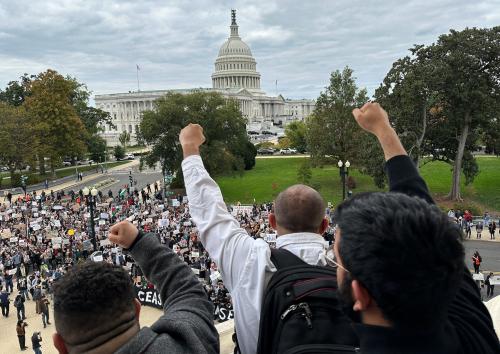As reported last week, American public support for Israel increased measurably in the two weeks after Hamas’s October 7 attack on Israel, across the partisan divide, compared with June. Our latest poll, taken four weeks after the attack, during a period when national and international attention had shifted to Israel’s subsequent attacks in the Gaza Strip, shows that Israel has lost much of that early support, especially among Democrats.
Change among young Democrats has been particularly notable: They are now twice as likely to view President Joe Biden as “too pro-Israeli” than in October, the number of those saying they would be less likely to vote for Biden because of his stance on the Israeli-Palestinian issue more than doubled since October, and those who want the United States to lean toward the Palestinians have measurably increased.
The University of Maryland Critical Issues Poll with Ipsos was carried out among 1,019 respondents from Ipsos’ probability-based KnowledgePanel, November 3-5, with a margin of error of +/- 3.4%. The questions made no reference to the war in Israel and Gaza, referring only to the Israeli-Palestinian issue, so as to track attitudes before, during, and, eventually, after the war. Here are three takeaways.
First, in our key tracking question probing if respondents want the United States to lean toward Israel, toward the Palestinians, or toward neither side, there was measurable change in the two weeks between the two polls. As noted in my report last week, “While those who wanted the United States to take the Palestinians’ side remained relatively constant since June, those who wanted the United States to lean toward Israel increased not only among Republicans but also among Democrats, going from 13.7% in June to 30.9% in October; it also increased among independents, going from 20.8% in June to 37.9% in October.”
In the latest poll, the number of respondents wanting the United States to take Israel’s side dropped across the partisan divide. This was coupled with a slight increase in the number wanting the United States to lean toward the Palestinians. Among Democrats, support for Israel dropped from 30.9% in the third week of October to 20.5% in early November, while support for Palestinians rose from 9.2% to 12.9%. During the same two-week period, the gap between Republicans wanting the United States to lean toward Israel and those wanting the United States to lean toward the Palestinians shrank from 70.7% to 60.8%; it likewise fell from 32.2% to 27.7% among independents. For all respondents overall, the gap decreased from 36.8% to 29.1%. At the same time, there was a rise across the board in the percentage of respondents who want the United States to take neither side, 53.5% overall, including 65.5% of Democrats, 31.6% of Republicans, and 57.5% of independents.
Young people (under 35) across the partisan divide were less likely to want the United States to take Israel’s side compared with October, but the change among young Democrats was especially striking. In the October poll, we found no change in the attitudes of young Democrats two weeks after the Hamas attacks from June, and those who wanted the United States to take the side of each were roughly equal. In the latest poll, there is a measurable change favoring the Palestinians. The percentage of those who wanted the United States to take the Palestinians’ side increased from 16.2% in October to 23.2% in November, while those who wanted to take Israel’s side rose from 14.7% to 15.9% (within the margin of error). Most young Democrats wanted the United States to take neither side, 59.8%, compared to 64.7% in October.
Second, there was a marked increase in the number of Democrats who said Biden is “too pro-Israeli,” rising from 24.4% in October to 34.4% in November, while Democrats who said Biden was “too pro-Palestinian” remained constant at 1.2%. There was no statistically significant change in the positions of Republicans and independents on this issue during the same period.
The change among young Democrats was striking. The percentage of young Democrats who said Biden was too pro-Israeli doubled, going from 20.6% in October to 41.5% in November, while a negligible number (from 0 to 2.4%) said he was too pro-Palestinian. To put this in perspective, if one excludes those who said they did not know where Biden stood on this, the percentage of young Democrats saying Biden was too pro-Israeli comes to 72.3%.
Third, the number of Democrats who said that Biden’s position on the Israeli-Palestinian issue made them less likely to vote for him if the presidential elections “were held today” increased from 10.8% in October to 14.8% in November, while those who said they would be more likely to vote for Biden decreased from 28.4% in October to 17.6%. The change in the positions of Republicans and independents on this issue was within the margin of error.
Young Democrats’ positions on voting for Biden changed the most: 20.7% said they would be less likely to vote for Biden based on his position on the Israeli-Palestinian issue, compared with 9.8% who said they would be more likely to vote for the Democratic president.
Conclusion
The two polls that we have conducted so far since the start of the war in Israel and Gaza show the biggest changes in attitudes that we have ever measured from poll to poll in years of tracking American public attitudes on the Israeli-Palestinian issue — and these changes are almost certainly related to the ongoing war. As this war continues, grabbing significant national and international attention, attitudes may remain fluid. The question is: will some segments of the public form a hardened view based on what they observe that will outlast the war, making this war a paradigm-forming event for some Americans? This question remains open, but what we find so far is that much of the initial bump in support for Israel that the American public exhibited early after the Hamas attack has not survived the reactions to the Israeli attacks in Gaza. We will continue to track these attitudes in the weeks ahead.
The Brookings Institution is committed to quality, independence, and impact.
We are supported by a diverse array of funders. In line with our values and policies, each Brookings publication represents the sole views of its author(s).









Commentary
Israel loses much of the support it gained after Hamas’s attack
November 8, 2023